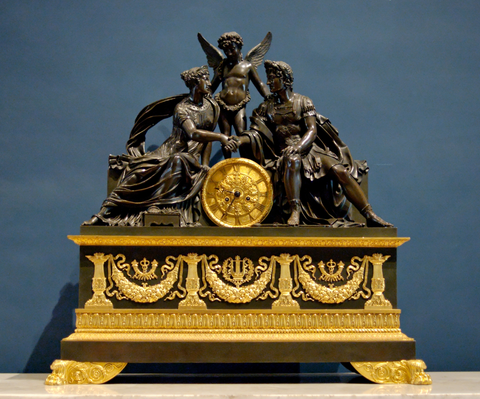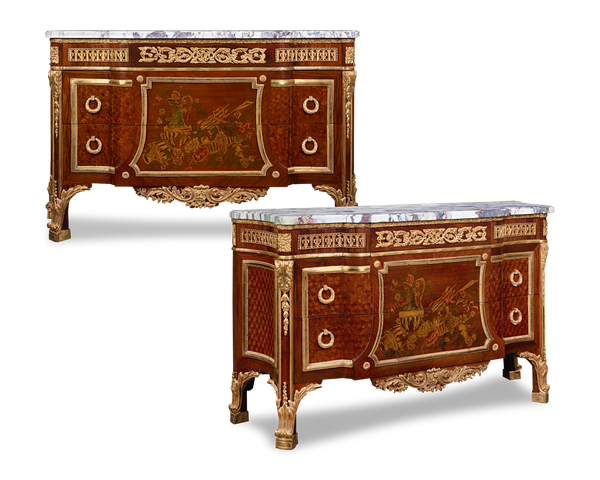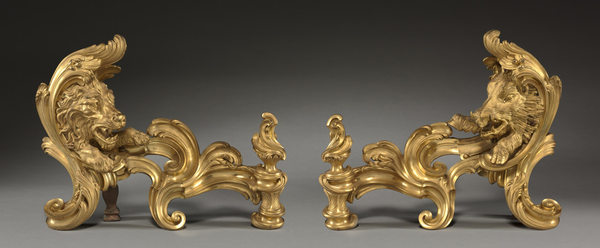Opulence, artistry, and timeless elegance – these are the hallmarks of ormolu, an art form that has adorned the finest interiors for centuries. From the delicate chimes of an intricate clock to the warm glow emanating from a lamp, these masterpieces encapsulate a rich history of craftsmanship.
Yet, as with all treasures, discerning the genuine from the replica is a skill coveted by collectors and enthusiasts. This exploration into the world of ormolu not only unveils its illustrious past but also offers a guiding hand in the art of identification, ensuring that every piece you encounter resonates with authenticity.
Ormolu Unveiled: A Glimpse into its Glittering History
The term "ormolu" is derived from French "or moulu," meaning "ground gold." It refers to a technique of gilding bronze with a mercury-gold amalgam.
This technique first appeared in France during the mid-17th century and required precision and creativity. Artisans would first create a model, around which a mold would be formed. After filling the mold and casting the alloy, the final product was chased and gilded. The resulting object had the warmth and beauty of gold, but the durability of its alloy.
Ormolu became increasingly popular in the 18th and early 19th centuries across Europe, and particularly in France. It was used to decorate a wide variety of objects, including furniture, clocks, chandeliers, candelabra and picture frames. These intricate mounts were also used to embellish porcelain and glass objects.
Ormolu was particularly associated with the Rococo and Neoclassical styles. Rococo ormolu mounts were characterized by their elaborate ornamentation and curvilinear forms. Neoclassical ormolu mounts were more restrained and symmetrical, often incorporating motifs from ancient Greece and Rome.
Louis XVI-Style Marquetry Commodes. Circa 1880. M.S. Rau, New Orleans.
The Neoclassical ormolu accents on these commodes exemplify the meticulous attention to detail required in crafting these objects.
As an art form, ormolu was adapted to produce a similar gold effect without the expense or danger of traditional methods. The original method to create ormolu required the use of powdered gold mixed with mercury, the concoction was heated until the mercury was transformed to gold. It was only in the late 19th century that the process evolved to incorporate electrolysis as an alternate method of gilding, due to health concerns surrounding the use of mercury.
Despite the fact that the use of mercury was discouraged due to health concerns, although many continued to use it to achieve the desired look of gold coating. Although all of the mercury was vaporized when the object was heated, making the final product safe for use, the craftsmen who worked with the material were at significant risk for exposure. In contrast, electrolysis was far cheaper and presented no dangers to the craftsmen.
The Timeless Appeal of the Ormolu Antiques
Ormolu on antique furniture can be found in a variety of shapes and sizes, but they are all characterized by their high level of craftsmanship and attention to detail. The popular styles of the 18th and 19th centuries were highly decorative, especially the Rococo and Regency antiques treasured by collectors today.
Ormolu was used as the crowning accent to take impressive pieces crafted from rare hardstones or woods to the next level. Clocks with ornamental metal mounts applied with careful precession also often featured complex movements as a demonstration of their owners wealth.
French Fluorspar and Ormolu Clock Garniture. 19th Century. M.S. Rau, New Orleans.
The vibrant hardstone used to craft this Rococo clock is fluorspar, which was first mined by the Romans. The fluorspar’s bright surface alternates between purple and green hues, and is accented by ormolu cherubs
applied to the clock case. With the inclusion of fluorspar, which was rarely seen in garniture sets, this piece would have sat on the fireplace mantel as the centerpiece of its owner's home.
 French Opaline Globe Gas Lamps. Circa 1890. M.S. Rau, New Orleans.
French Opaline Globe Gas Lamps. Circa 1890. M.S. Rau, New Orleans.
These lamps are a testament to the skill of the craftsmen who created them and the opulence of the patrons who commissioned them. The rare opaline glass globes feature intricately painted details and rest upon ormolu bases.
Because ormolu could be added to many different objects, from clocks and lamps to tables and more, there is a perfect ormolu antique available for any area of your home. Whether you’re looking for a crowning centerpiece for your entryway or hoping to add opulence to your dining room, ormolu antiques make a fantastic addition.
Ormolu's Legacy: Key Craftsmen and Iconic Pieces
Ormolu can be seen on some of the finest furniture of the 18th and 19th centuries, many of which are now housed in museums or private collections, and treasured for their craftsmanship. Notable examples can be found in the Metropolitan (New York), The British Museum and the Victoria & Albert Museum.
In France, the guild system dictated who was able to craft ormolu, and the work primarily fell to the bronze makers rather than cabinet makers, who were only able to attach the crafted pieces to their furniture.
This means that while many of the famed cabinetmakers of this period used ormolu in their creations, they were not the actual craftsmen behind these gilt objects. As ormolu pieces are very rarely signed, it is often difficult to attribute a specific object to a known maker, even when the cabinetmaker’s identity is known.
One notable exception to this rule is the work of Jacques Caffieri, a famed bronze worker who created fantastic ormolu works for King Louis XV, which decorated many of his palaces, from Versailles to the Chateau de Marly.
He crafted many important pieces for the crown throughout his lifetime, assisted by his father initially and later by his son. Because of his impressive craftsmanship and choice to sign many of his works, Caffieri has a remarkable number of pieces that can attributed to him, which can be found in museums today.
Pair of gilt-bronze andirons by Caffieri. 1752. Cleveland Museum of Art.
These fantastic andirons would have accented a fireplace, although their impressive condition signals that they were likely never used for their intended purpose of supporting firewood. The highly-detailed animals demonstrate the impressive capabilities of Caffieri, who truly mastered the intricacies of the Rococo style.

French Empire mantel clock. Circa 1810. The Louvre Museum, Paris.
Pierre Philippe Thomire was another notable French sculptor, who crafted fantastic ormolu pieces for the First French Empire in the Neoclassical style. His ormolu handles accent famed Sèvres porcelain vases, and at his highest levels of production, Thomire employed six to seven hundred workers.
How to Identify Genuine Ormolu: A Collector's Guide
Whether you’re looking to learn more about an ormolu object already in your collection or interested in acquiring a new piece but unsure of its value, learning to identify
the genuine craft can be an important skill. While it’s always a good idea to consult an expert, these tips serve as a great starting point for any collector.
-
Weight: Genuine ormolu is heavy. Replicas, on the other hand, are often made of lighter materials, such as aluminum or plastic.
-
Color: True ormolu has a warm, golden glow. Replicas, on the other hand, often have a brassy or yellow color.
-
Patina: The real deal often develops a patina over time. Patina is a thin layer of oxidation that gives the gilt a mellower color and a more subdued luster. Replicas, on the other hand, often do not develop a patina.
 Grand Tour Marble and Ormolu Obelisks. Circa 1850. M.S. Rau, New Orleans.
Grand Tour Marble and Ormolu Obelisks. Circa 1850. M.S. Rau, New Orleans.
In addition to these characteristics, learning to identify popular design periods that employed ormolu, like Rococo or
Regency style, can help distinguish the genuine from inauthentic.
Ormolu would have only been used to accent pieces of a high caliber, so checking the other materials used in an items construction can indicate whether the ormolu is authentic or not. Ormolu components were rarely signed, but you may be able to identify a makers mark on other components of the piece.
If learning about ormolu has piqued your interest, check out our expansive collection of
French antiques.












